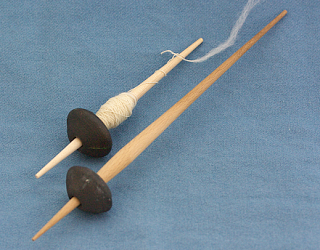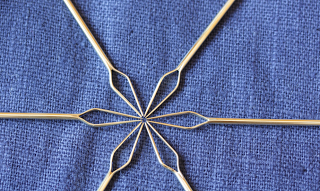For most of the things that I carry in my market stall and shop, there is one main reason for them being there: it's stuff I wanted, needed, or lusted after and could not get.
Much of the materials and tools common (or at least available) in medieval times are not common anymore, and some of them have outright died out. A lot of more modern tools - still made and used 30 or 50 years ago - are also slowly inching out of existence, not being manufactured anymore because the buyer prefers a cheaper mass-made version.
So when I tried to find gold thread - tough luck. Spindle sticks? Good quality netting needles? High-quality linen thread? Really, really hard to find (sometimes it's even hard to find somebody still able, and willing, to make them).
Most of the things I carry are thus made on order, just for my store, by someone able and willing to do the things like I want them (which is sometimes slightly weird-sounding to modern ears). Which means that getting a new product into the store takes a lot of time and effort spent in researching, prototyping, testing, and finding someone to produce it. Sometimes, that means a lot more time elapses than one would deem reasonable. Or that something is half-planned, but then has to stand back behind other, more pressing issues and projects. It also means that sometimes, a product runs out and I'm not able to replace it, because the person or company has quit, or some material is no more available, or similar issues. Or that it would be possible to make something, but is not really affordable - for me to stock it, or for you to buy it.
All this, however, also adds to the experience for me. Yes, I'd sometimes prefer stuff to be easier - but at least this way, I can be sure that everything is just so, and you can be sure that the things you get at pallia are sourced and selected carefully, and often made by very small companies or individual artisans.
Just in case you are curious now about my current object of desire - it's cutting edges. Shears and scissors, to be precise. I am searching for forms documented for the medieval times, and there has been a lead... so I am following it. Who knows, maybe in a few weeks or months, I may be able to offer tools for your cloth-cutting, too. Which would be... enormously exciting for me. And I hope for you as well!
Much of the materials and tools common (or at least available) in medieval times are not common anymore, and some of them have outright died out. A lot of more modern tools - still made and used 30 or 50 years ago - are also slowly inching out of existence, not being manufactured anymore because the buyer prefers a cheaper mass-made version.
So when I tried to find gold thread - tough luck. Spindle sticks? Good quality netting needles? High-quality linen thread? Really, really hard to find (sometimes it's even hard to find somebody still able, and willing, to make them).
Most of the things I carry are thus made on order, just for my store, by someone able and willing to do the things like I want them (which is sometimes slightly weird-sounding to modern ears). Which means that getting a new product into the store takes a lot of time and effort spent in researching, prototyping, testing, and finding someone to produce it. Sometimes, that means a lot more time elapses than one would deem reasonable. Or that something is half-planned, but then has to stand back behind other, more pressing issues and projects. It also means that sometimes, a product runs out and I'm not able to replace it, because the person or company has quit, or some material is no more available, or similar issues. Or that it would be possible to make something, but is not really affordable - for me to stock it, or for you to buy it.
All this, however, also adds to the experience for me. Yes, I'd sometimes prefer stuff to be easier - but at least this way, I can be sure that everything is just so, and you can be sure that the things you get at pallia are sourced and selected carefully, and often made by very small companies or individual artisans.
Just in case you are curious now about my current object of desire - it's cutting edges. Shears and scissors, to be precise. I am searching for forms documented for the medieval times, and there has been a lead... so I am following it. Who knows, maybe in a few weeks or months, I may be able to offer tools for your cloth-cutting, too. Which would be... enormously exciting for me. And I hope for you as well!





